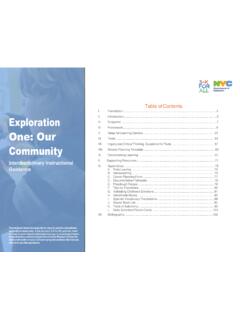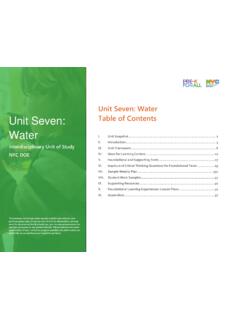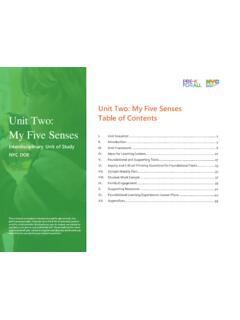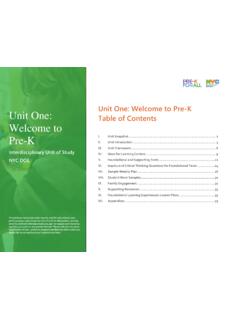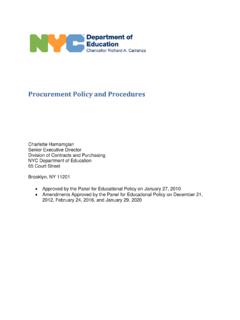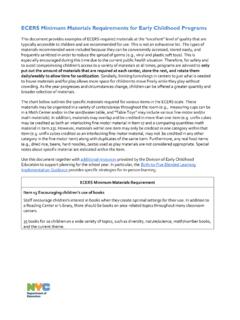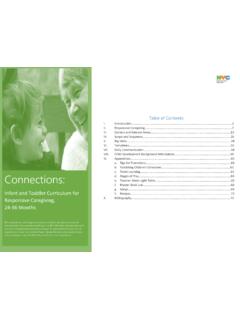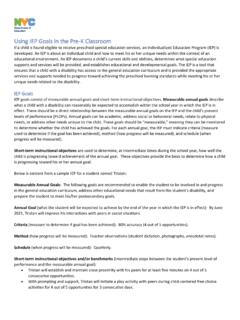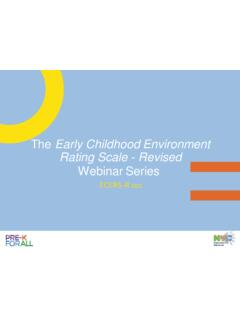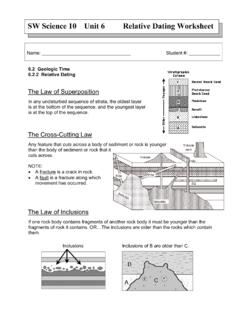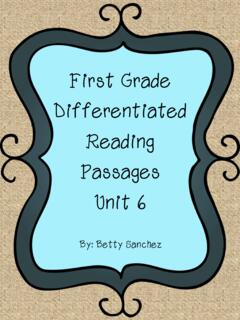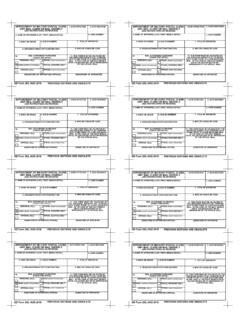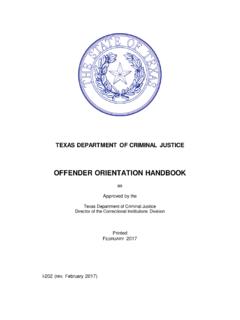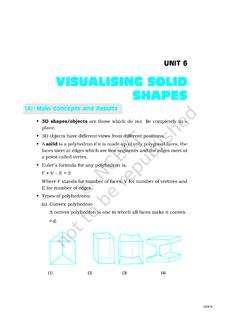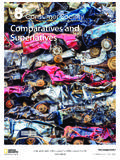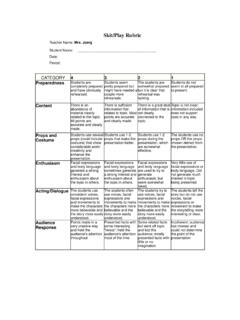Transcription of Unit 6 Light - infohub.nyced.org
1 unit Six: Light Table of Contents I. unit Snapshot .. 2 II. Introduction .. 4 III. unit Framework .. 6 IV. Ideas for Learning Centers .. 10 V. Foundational and Supporting Texts ..24 VI. Inquiry and Critical Thinking Questions for Foundational Texts .. 26 VII. Sample Weekly 29 VIII. Student Work Samples .. 35 IX. Supporting Resources .. 37 X. Foundational Learning Experiences: Lesson Plans .. 38 XI. Appendices ..54 unit Six: Light Interdisciplinary unit of Study NYC DOE The enclosed curriculum units may be used for educational, non-profit purposes only.
2 If you are not a Pre-K for All provider, send an email to to request permission to use this curriculum or any portion thereof. Please indicate the name and location of your school or program and describe which units you would like to use and how you intend to use them. unit SNAPSHOT 2 I. unit Snapshot unit Topic: Light Essential Question How and why do we use different kinds of Light ? Focus Questions What kinds of lights are around us? What is darkness? How does Light help us? What are shadows? Student Outcomes Enduring understandings that the student should have by the end of the unit : There are many types of lights in our homes and our cities.
3 Light helps us see and stay warm. Light helps plants grow. When there is little or no Light it is dark. Shadows appear when an object blocks Light . Connected Academic Vocabulary This list should be adapted to fit the needs of individual programs and classrooms. battery blackout candle clouds curve dark day diurnal electricity eyes eyesight fire firefly flame flashlight grow heat horizontal lamp lantern Light Light bulb lightning lines melt mirror moon night nocturnal opaque outline parallel rainbow reflection see shade shadow sight silhouette solar power spiral stars straight street Light sun sunglasses traffic Light translucent transparent vertical wavy weather zigzag unit SNAPSHOT 3 Focus StandardsFrom the New York State Prekindergarten
4 Learning Standards (NYSPLS) Domain 1: Approaches to Learning Approaches tasks and problems with creativity, imagination and/or willingness to try new experiences Domain 2: Physical Development and Health Uses senses to assist and guide learning. Demonstrates coordination and control of large muscles Demonstrates awareness and understanding of safety rules Domain 3: Social and Emotional Development Recognizes self as an individual having unique abilities, characteristics, feelings and interests Domain 4.
5 Communication, Language and Literacy Approaches to Communication Demonstrates a growing receptive vocabulary English Language Arts and Literacy Reading Foundations [ ] Demonstrates understanding of the organization and basic features of print Reading [ ] Participates in discussions about a text ( , during whole or small group interactive read-aloud discussions, during peer sharing, within play scenarios) Speaking and Listening [ ] Demonstrates command of the conventions of academic English grammar and usage when writing or speaking.
6 [ ] Explores and discusses word relationships and word meanings Domain 5: Cognition and Knowledge of the World Mathematics [ ] Duplicates and extends simple patterns using concrete objects ( , what comes next?) Science [P-PS3-1.] Participates in an investigation to determine the effect of sunlight on Earth s surface. Social Studies Demonstrates knowledge of the relationship between people, places, and regions The Arts [ ] Responds to Theatrical Arts INTRODUCTION 4 II. Introduction Welcome to unit 6: Light , Pre-K for All s sixth Interdisciplinary unit of Study.
7 In unit 6: Light , children move from exploring various modes and aspects of transportation to inquiring and thinking critically about Light , darkness and shadows. This unit , like all Pre-K for All units, provides opportunities for children to observe objects and phenomena in their environment with increasing complexity. In this unit , children have the opportunity to deepen their understanding of natural and manufactured sources of Light .
8 Activities throughout the unit prompt children to explore Light , darkness and shadows with hands-on materials as well as provide opportunities for children to make predictions and think about their world in increasingly abstract ways. In Section IV: Ideas for Learning Centers, as well as throughout the unit , there are opportunities and examples of how children can use a Light table (a flat panel or table that has a backlit surface) in combination with other objects.
9 Many classrooms will not have a Light table. See Section XI: Appendices for information on creating a Light table with recycled and/or easily attainable materials. We also recognize that in talking about Light and shadow, children may ask questions about people who do not see clearly. Please see Section XI: Appendices, for some guidance on how to discuss this with children. Most Interdisciplinary Units of Study are structured around four focus questions. Each focus question is designed to take about one week to explore.
10 In the Light unit , children begin by considering the first question, What kinds of Light are around us? Children will observe, discuss and explore what they know about natural and manufactured Light . In the second week, children will have learning experiences and explore activities that encourage them to think about darkness. In the third week, children focus on the question, How does Light help us? They will continue to consider the how Light affects our world, for example through conducting an experiment on growing plants in the Light and in the dark.

